
Geranium cinereum, the ashy cranesbill, is a species of flowering plant in the family Geraniaceae, native to the Pyrenees. Growing to 50 cm (20 in) tall and wide, it is a small, deciduous or semi-evergreen perennial usually grown for low ground cover, rockeries or underplanting larger subjects like roses. Leaves are deeply divided and grey-green - whence The Latin specific epithet cinereum “ash-grey”.. It flowers in summer, with striking black-eyed flowers with black stamens. The plant grows in full sunlight, and is hardy down to −15 °C (5 °F).

Geranium maderense, known as giant herb-Robert or the Madeira cranesbill, is a species of flowering plant in the family Geraniaceae, native to the island of Madeira. It is sometimes confused with another Madeira endemic, Geranium palmatum.

Geranium × magnificum, the purple cranesbill, is a species of hardy flowering herbaceous perennial plant in the genus Geranium, family Geraniaceae. The multiplication symbol × indicates that it is the result of hybridisation, in this case between Geranium platypetalum and Geranium ibericum. Growing into a clump 70 cm (28 in) high and broad, it has the decorative, deeply-lobed leaves typical of the genus Geranium. Violet-blue flowers with darker veins are borne relatively briefly in early summer. Extremely hardy, to below −20 °C (−4 °F), it is suitable for cultivation throughout all temperate regions. This plant has gained the Royal Horticultural Society's Award of Garden Merit.
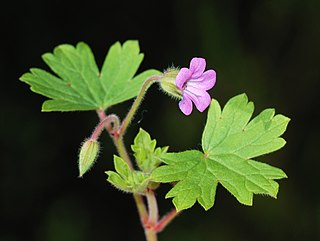
Geraniaceae is a family of flowering plants placed in the order Geraniales. The family name is derived from the genus Geranium. The family includes both the genus Geranium and the garden plants called geraniums, which modern botany classifies as genus Pelargonium, along with other related genera.

Pelargonium is a genus of flowering plants which includes about 280 species of perennials, succulents, and shrubs, commonly known as geraniums, pelargoniums, or storksbills. Geranium is also the botanical name and common name of a separate genus of related plants, also known as cranesbills. Both genera belong to the family Geraniaceae. Carl Linnaeus originally included all the species in one genus, Geranium, and they were later separated into two genera by Charles Louis L'Héritier de Brutelle in 1789.
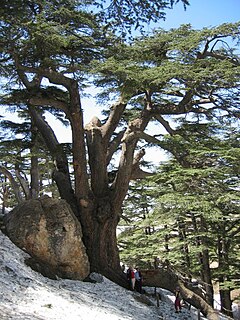
Cedrus libani, the cedar of Lebanon or Lebanon cedar, is a species of tree in the pine family Pinaceae, native to the mountains of the Eastern Mediterranean basin. It is a large evergreen conifer that has great religious and historical significance in the cultures of the Middle East, and is referenced many times in the literature of ancient civilisations. It is the national emblem of Lebanon and is widely used as an ornamental tree in parks and gardens.
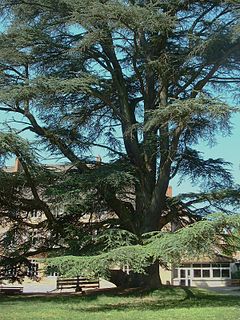
Cedrus atlantica, the Atlas cedar, is a species of tree in the pine family Pinaceae, native to the Atlas Mountains of Morocco, to the Rif, and to the Tell Atlas in Algeria. A majority of the modern sources treat it as a distinct species Cedrus atlantica, but some sources consider it a subspecies of Lebanon cedar.

Geranium sanguineum, common names bloody crane's-bill or bloody geranium, is a species of hardy flowering herbaceous perennial plant in the cranesbill family Geraniaceae. It is also the county flower of Northumberland.

Geranium sylvaticum, the wood cranesbill or woodland geranium, is a species of hardy flowering plant in the family Geraniaceae, native to Europe and northern Turkey.

Geranium viscosissimum, commonly known as the sticky purple geranium, is a perennial in the flowering plant family Geraniaceae. It is thought to be a protocarnivorous plant.

Ixora coccinea is a species of flowering plant in the family Rubiaceae. It is a common flowering shrub native to Southern India, Bangladesh, and Sri Lanka. It has become one of the most popular flowering shrubs in South Florida gardens and landscapes. It is the national flower of Suriname.

Geranium dalmaticum, commonly called Dalmatian cranesbill, is a species of hardy flowering herbaceous perennial plant in the genus Geranium of the family Geraniaceae. It is native to Dalmatia on the west coast of Croatia. Growing to only 10 cm (3.9 in) tall by up to 50 cm (20 in) broad, it is cultivated as a garden subject in temperate regions for its low mound of aromatic leaves and soft mauve colored flowers. The palmately lobed glossy green leaves are tinted red in the Autumn. It has gained the Royal Horticultural Society's Award of Garden Merit.

Geranium psilostemon, commonly called Armenian cranesbill, is a species of hardy flowering herbaceous perennial plant in the genus Geranium, family Geraniaceae. It is native to Turkey, Armenia, Azerbaijan, and the Russian Federation. Forming a large clump to 120 cm (47 in) tall, it has glowing reddish purple colored flowers with prominent dark centres, and divided leaves tinted red in Autumn. It is cultivated as a garden subject, and a number of different cultivars exist. G. psilostemon has the UK’s hardiest rating, surviving temperatures as low as −20 °C (−4 °F).
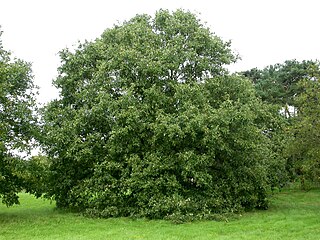
Quercus libani, the Lebanon oak, is a species of oak native to the eastern Mediterranean in western Asia, including in Lebanon, western Syria, northeastern Israel, eastern Turkey, and northern Iraq and Iran.

Geranium subcaulescens is a species of flowering plant in the geranium family Geraniaceae, that is native to Italy, Turkey and the Balkans. A low, mounded evergreen perennial, it typically grows to 8 in (20 cm) tall by more than 11 in (28 cm) broad, with grey-green orbicular and lobed leaves, and masses of bright magenta pink flowers with black centres in summer.

Geranium reuteri, the giant geranium, is a species of flowering plant in the family Geraniaceae, native to the Canary Islands and Madeira. It was known for many years under the name Geranium canariense. In Spanish, it is called pata de gallo.

Pelargonium × hortorum,, is a nothospecies of Pelargonium most commonly used as an ornamental plant. It is a hybrid between Pelargonium zonale and Pelargonium inquinans. They are the group of Pelargonium cultivars, with leaves marked with a brown annular zone and inflorescence in the form of large balls of tight flowers, usually red, pink or white. These are the most common geraniums of garden centers and florists, sold in pots for windowsills and balconies or planted in flowerbeds.

Geranium wallichianum is a species of hardy flowering herbaceous perennial plant in the genus Geranium, family Geraniaceae. It is native to the Himalayas. It grows to 60 cm with hairy toothed leaves and blue flowers in summer. It is suitable for cultivation in temperate regions, in the front of the border. Various cultivars have been selected of which 'Buxton's variety' has gained the Royal Horticultural Society's Award of Garden Merit.

Geranium solanderi is a species of plant in the family Geraniaceae. It is native to Australia, and to New Zealand.
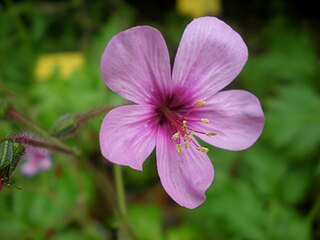
Geranium palmatum, the Canary Island geranium, is a species of flowering plant in the family Geraniaceae, native to the islands of Madeira. Growing in a rosette 1.5 m (4.9 ft) tall by 1 m (3.3 ft) broad, it is an evergreen perennial with divided palmate leaves and pink flowers 4 cm (1.6 in) in diameter on long red stems.



















